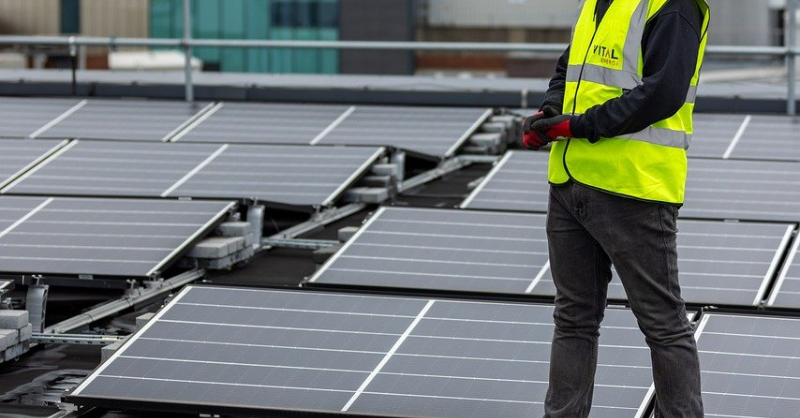
Heat pumps powered by wind and solar?
As the percentage of renewables on our grids grows, we need to think differently about how we use and store electricity - part of the answer is better matching supply & demand
Summary: An Institute of Engineering and Technology paper studies the role of system flexibility in accommodating more wind and solar including how and when energy is consumed, storage and hybrid approaches.
Why this is important: Much of the analysis of our future electricity system that we read assumes that just building lots of renewables (wind and solar) will "fix" the decarbonisation challenge, and/or that the electricity system of the future will operate pretty much as it does now. So, a focus on supply. To be fair, part of this seems to be driven by our love of simple stories - in this case decarbonising supply. This analysis is only partly right, yes, we need more renewables, but we also need more investment in electricity system stability and flexability.
The big theme: As the percentage of renewable electricity generation on the grid increases, the way we think about and use electricity will change. Unlike fossil fuels, wind and solar have a very low marginal cost of supply. This is both a blessing and a curse. It's a blessing as we will have periods of very cheap electricity. It's a curse because this can make it harder for investors in renewables to earn their target rate of return. There is a massive opportunity for investors to use technology and innovative approaches to overcome this challenge.

The details
Summary of a research paper from the Institution of Engineering & Technology:
As our electricity systems transition towards higher shares of renewables, especially wind and solar, the need for additional levels of system flexibility increases. Some of this can come from energy consuming sectors, such as transport and heating as they shift to electricity power from fossil fuels. Flexibility measures studied include hybrid heating in domestic and industrial processes, the smart charging of electric vehicles, renewable hydrogen & power to ammonia, peak shaving demand response, and batteries.
Let's take a look at why this is important...
Why this is important
Much of the analysis of our future electricity system that we read assumes that just building lots of renewables (wind and solar) will "fix" the decarbonisation challenge, and/or that the electricity system of the future will operate pretty much as it does now. So, a focus on supply. To be fair, part of this seems to be driven by our love of simple stories - in this case decarbonising supply. This analysis is only partly right, yes, we need more renewables, but we also need more investment in electricity system stability and flexibility.
We argue that investors need to start thinking about the dynamic in a different way, it's not just about supply and existing demand. This new way of thinking will open up a lot of really interesting investment opportunities, and perhaps help avoid some blind alley's. We plan to tackle the wider topic in a soon to be published longer blog, but for now we want to focus on a couple of the implications of studies like the one above, which looked at future power systems on the island of Ireland (yes, we know it's two countries, but for the purposes of electricity supply is a single, fairly isolated system). This report really raises two questions - first, can some electricity demand be better aligned with periods of excess (cheap) renewable electricity? Second, can we use and store the cheap surplus electricity and reuse it later for heating buildings?
Before digging into this, we need to be clear. This is a topic for those investors who think ahead, this is not going to be a quick win. While we have most of the technologies we need, bringing them together in a cost-effective manner is going to need support from governments, both upfront for capital spend and via policy support. Why might they provide this support. Put simply, buildings currently account for around 40% of the energy consumed in the European Union. And most of that is fossil fuels, especially gas. As the Czech Minister of Industry and Trade said recently, "Energy savings in buildings will help us reduce our energy bills and get rid of our dependence on Russia."
The latest Climate Action Plan (CAP) for Ireland states that 70% of electricity should come from variable renewable energy (VRE) by 2030. By way of comparison, only a few countries, such as Denmark and Portugal, source over 50% of their electricity consumption from variable renewables. So, the Ireland plan is a big step up. The old starting point for analysing this plan would be to start with projected demand and see if the supply can match it, but as this report highlights, the future can look very different from the past. In order for the Irish CAP to be successful, there is a need to flexibly utilise electricity in some energy consuming sectors, such as transport and heating. We discussed a different way of thinking about EV charging in an earlier blog, the focus today is on heating and specifically the use of heat pumps.
Let's start with industrial heat (which we also discussed in a recent blog). Here, the cost benefit ratio from using heat pumps was very positive, ranging between 3.7x and 6.2x. So put simply an investment in industrial heat electrification would have a positive payback, and this excludes any benefits to the wider society. But, for building heating, the cost benefit was less than 1x, so in the absence of government support on installation costs, the economics for a building owner often do not stack up. This is consistent with a recent IEA report, which highlighted that from a purely financial perspective, heat pump economics are best in countries like Sweden, where "the combination of a carbon tax and relatively low equipment costs for heat pumps make the later more competitive than fossil fuel heating in most cases".
At this point you are probably thinking, hang on, if this is the case, why would I invest in heat pumps for buildings. Obviously, one reason is that many governments are already subsiding the capital cost of heat pumps. These subsides are important, as its the upfront cost that mainly what pushes the economics in favour of gas boilers. This is leading to a surge in installations.

But there is also the issue of system flexibility and ways that using demand management can actually lead to lower system costs, so savings for everyone. You will recall that right at the start we talked about the low marginal cost of supply for wind and solar. This raises two issues - first, can we match some building heating demand to periods of excess (cheap) renewable electricity supply, and second, can we use and store any very cheap electricity and reuse it later for heating buildings.
Taking these in order. This study, from the Hertie School in Berlin, identified that in some markets where the demand for heating (winter) is positively correlated with supply of wind (it is windier in the winter), the use of wind energy and heat pumps can provide a way of aligning demand with periods of excess and cheap supply. One example of this is below - which shows offshore wind generation for Belgium. So put simply, in some markets we can shift building heating from the use of fossil fuels (mainly gas) to using an over supplied renewable electricity source.

And on storing the cheap electricity (not using batteries) this report looked at the use of heat pumps with thermal storage. This is a less developed topic, and there are the obvious issues around extra capital costs, but work is being done on how combining renewables (in this case wind), with heat pumps & thermal storage can reduce total system costs. And we have real world examples being built, such as this one in New England. Here two low-income facilities are being retrofitted with heat pumps that store thermal energy for heating and air-conditioning during off-peak hours, and discharge that energy during peak hours, when energy is expensive.
Something a little more bespoke?
Get in touch if there is a particular topic you would like us to write on. Just for you.
Contact us
Please read: important legal stuff.

